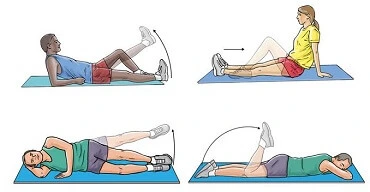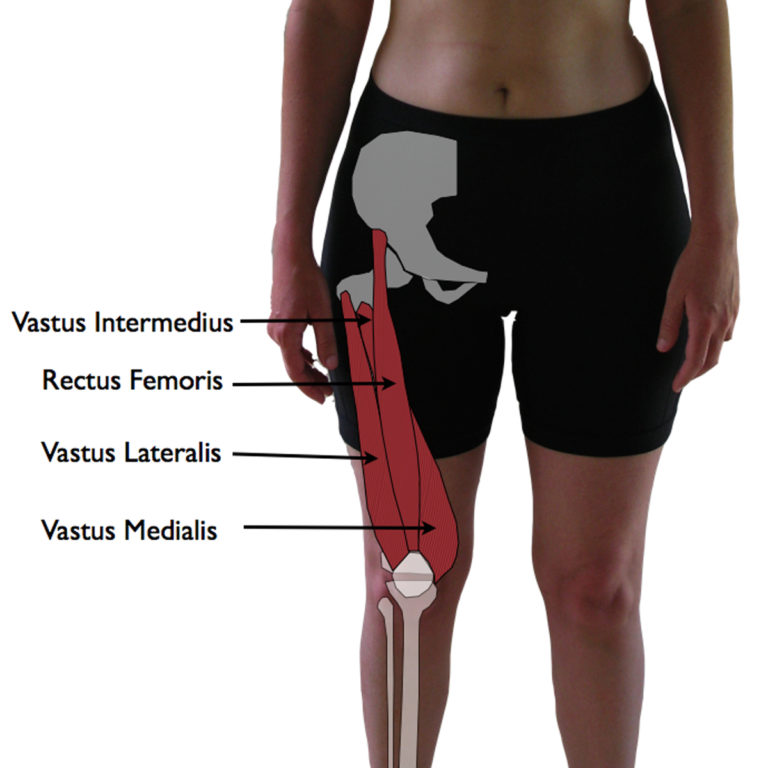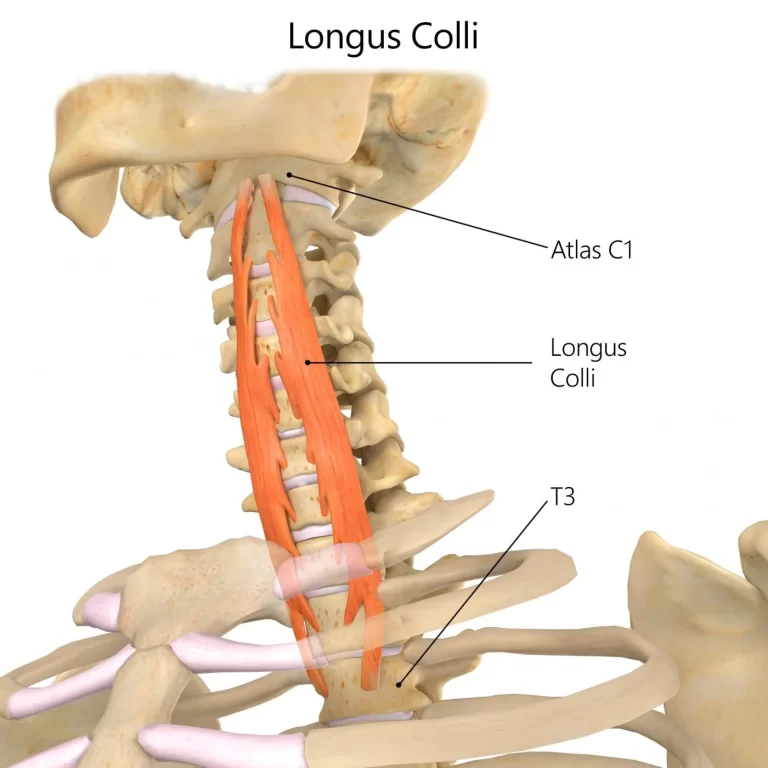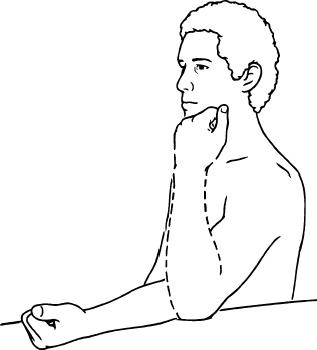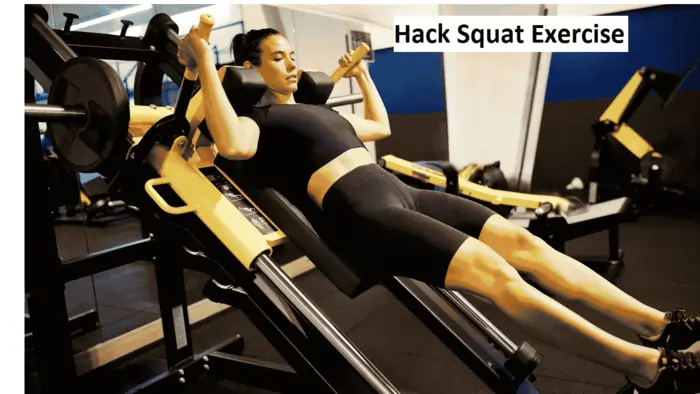46 Best Exercise for Weak Knees & Stretches
Exercise is a great option to strengthen your weak knee. Strengthening & stretching exercises of the Knee Muscles keep your knee powerful and flexible.
Table of Contents
Introduction:
Knees deteriorate with aging naturally. The knees may weaken from overuse as well. Maintaining their strength through exercise is crucial for healthy knees. In order to keep your knee strong, you only need to perform regular, low-intensity exercises.
To increase knee strength, joint stability, and support, perform general knee strengthening exercises that strengthen the quadriceps, hamstrings, gluteus, and calves (the surrounding muscles).
It’s important to take care of your knees because they support a lot of your body weight. Your knees’ strength can be significantly reduced by simple wear and tear, which can be painful.
The knees are the biggest joints in the human body. The tibia, femur, and patella, often known as the kneecap bone, are three bones that are joined to form a hinge joint. Healthy people have ligaments and cartilage in their knee joints that act to support the joint and keep it stable. However, overuse and aging may cause these structures to degenerate over time, which could result in weak knees. Overuse injuries, quadriceps weakness, and osteoarthritis are among the most typical causes of knee weakness. According to the World Health Organisation, osteoarthritis affects 10% of males and 18% of women who are 60 years old and older.
One of the most effective strategies to treat knee pain and prevent its recurrence is through knee strengthening exercises.
People who perform knee-strengthening exercises have less pain, heal from injuries more quickly, function better, and experience fewer pain flare-ups.
When the leg muscles are weak, the knee joint is not supported as effectively, which causes more weight to pass through the bones and increases the likelihood of developing knee issues. Exercises to strengthen the knees might assist.
Whether you’re seeking for knee strengthening exercises for runners, after an injury, with arthritis, or practically any other knee ailment, all of the exercises included here are simple to do, quick, effective, and appropriate for most individuals.
Weak Knees Causes:
Weak knees can be brought on by a variety of factors, such as illnesses, accidents, and overuse. Among the most frequent causes are:
Arthritis
Sprains and strains
Ligament or cartilage damage
Knee joint infection
A lack of physical activity
Iliotibial band Syndrome
Muscle weakness
Your weak knees can be correctly diagnosed by a doctor, who can also advise you on the best course of action.
Physical therapy as a treatment for knee weakness:
It has been discovered that physical therapy and rehabilitation programs are useful in treating knee issues. Physical treatment regularly can assist increase quadriceps muscle strength and range of motion while easing general knee weakness stiffness and discomfort. As they might benefit the most, it may be especially advised for people with mild pain and knee weakness. Additionally, the physiotherapist might suggest some exercises that can be done at home with the right footwear. In order to lessen the strain on the knee, they could also assess the patient’s posture and encourage them to improve it.
What exercises strengthen the knees?
- Knee strengthening exercises are a terrific way to strengthen the knee joint and muscles so that you can accomplish all of your activities easily and without putting yourself under extra pressure. Additionally, they are also very good for your health.
- If the knee is weak, there is a danger of damage during daily activities like walking, sitting, standing, or ascending stairs.
- The best method to prevent knee-related injury is for the patient to be health-conscious and to engage in regular exercise.
- The knee joint is the biggest. The person uses it a lot when performing daily activities including walking, running, climbing, and even jumping.
- Due to this, this joint is particularly vulnerable to pain and injury. The doctor can suggest activities to assist the patient strengthen the muscles around the knee joint when pain or even injury arises.
- Knee discomfort can affect people of any age. The most prevalent orthopedic issue in athletes is Anterior Knee pain, sometimes known as the runner’s knee.
- Knee discomfort is a typical issue for athletes, but it may also be a concern for those with arthritis.
- When knee pain occurs, many are tempted to forgo exercising, but this is not always the best course of action.
- By giving the knee additional support, many different types of exercise also help to lessen current knee pain and prevent future pain or even injury.
- By consistently strengthening the muscles around the knee joint, the patient can help to lessen the strain on the knee joint.
- The femur, or thigh bone, and the tibia, or shin bone, make up the knee joints. The patella and the fibula, which are tiny bones that run alongside the tibia, are the additional bones that make up the knee joint.
- This synovial joint, which resembles a hinge, primarily permits flexion and extension motions (along with a little amount of medial and lateral rotation).
- The patella, femur, and tibia articulate to create this. The patient must concentrate on movements that engage the hamstrings, quadriceps, glutes, and hip muscles if they are to strengthen the knee joint.
Health Benefits of knee strengthening exercises:
- The best non-surgical treatment for osteoarthritis is exercise. The strong and flexible muscles may protect the knees from harm and maintain their health.
- Regularly strengthening your quadriceps can help to make it simpler to extend your knee and flex your hip.
- Helps the quadriceps muscles to get stronger.
- Increases the kneecap’s stability by doing this.
- Aids in protecting the knee joint from harm. Aids in increasing leap height.
- Aids in improving all-around athletic abilities.
- Decreases the likelihood of getting knee osteoarthritis.
- Improving stability and balance. Simple movements like walking, bending, sitting, and running become easier with stronger knees.
- Although the knee joint is not immediately impacted by this exercise, the muscles surrounding it will be strengthened. Strong muscles in the area of the knees may aid in supporting the knees. With its support, the knee joints may experience less stress and pressure, which helps to relieve knee discomfort and encourages an individual to be more active.
- The knee muscles can be strengthened by performing the exercises shown below. The client should cease practicing these exercises and speak with a physical therapist if they are in pain while doing them. Before performing this exercise, a person with excruciating knee discomfort should speak with a doctor.
There are the following exercises to strengthen your knees:
Best knee strengthening exercises:
These are an excellent way to start whether you’ve never done workouts before, are seeking knee-strengthening exercises after an accident or surgery, or either has weak knees. Continue to the Intermediate and Advanced knee strengthening exercises sections after you feel comfortable with them.
Straight leg raises:
The straight leg raise tones your quadriceps, hip flexors, and abdominal muscles. At the end of the workout, flexing your foot should cause your shins to become tight.
As the workout becomes simpler, you can add a 5-pound ankle weight and gradually raise the weight as your leg strength improves.
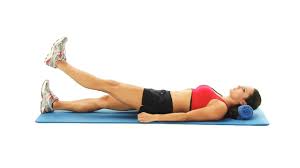
How to perform this exercise for strengthening:
This exercise is quite simple to carry out, and the patient may do it right there.
The patient might utilize the mat as additional padding beneath the back while executing this exercise.
Lie on the ground with one leg extended in front of you and one knee bent.
Slowly elevate the straight leg off the floor by contracting its quadriceps until it is at the same height as the knee that is bent.
Wait five seconds at the peak before lowering to the starting position.
On each leg, perform one to two sets of ten repetitions.
What not to do:
During the exercise, try not to let your back arch.
Avoid lifting the bent leg above the knee or jerking or bouncing it.
This exercise shouldn’t be done by anyone with osteoporosis or a back compression fracture.
Side leg raises:
This exercise uses the hip abductors and glutes.
The hip abductor muscles, located on the outside of the pelvis, help the patient stand, walk and turn the legs easily. Strengthening these muscles can help the patient prevent and treat hip and knee pain.
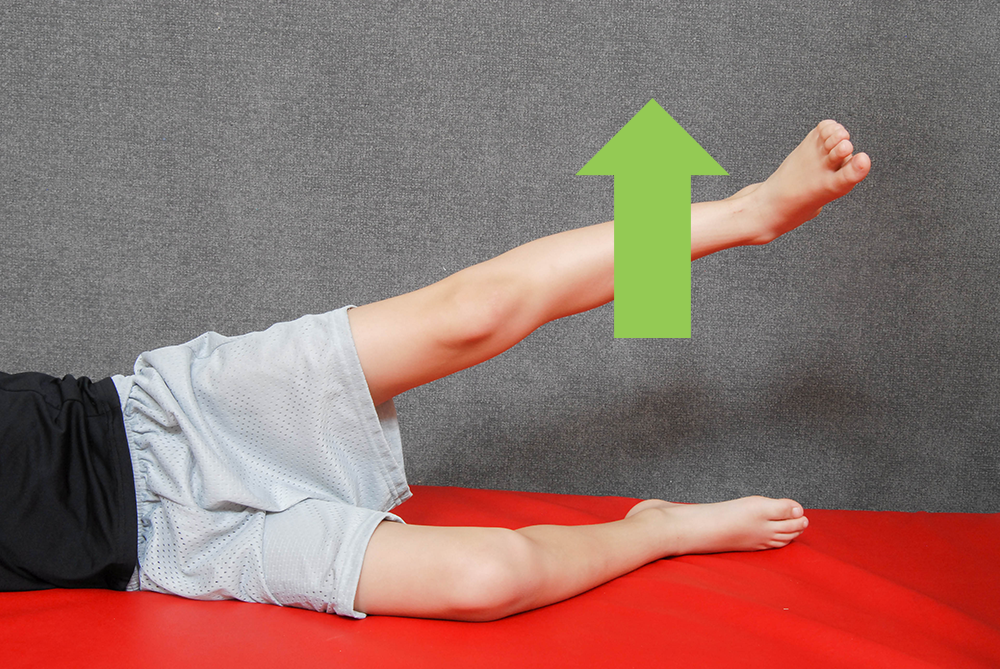
How to do this strengthening exercise:
To perform this exercise, the patient should lie on his side with his legs crossed.
Hold your head in one hand and place the other hand on the floor in front of you.
Raise the top as much as the patient can comfortably. Pause for two seconds at the top, then lower the leg down. Do one to two ten to twenty repetitions with each leg.
Prone leg raises:
This exercise uses both the hamstrings and glutes. As this exercise becomes easier, the patient can increase the 5-pound ankle weight and gradually progress to a heavier weight as the patient builds leg muscles.
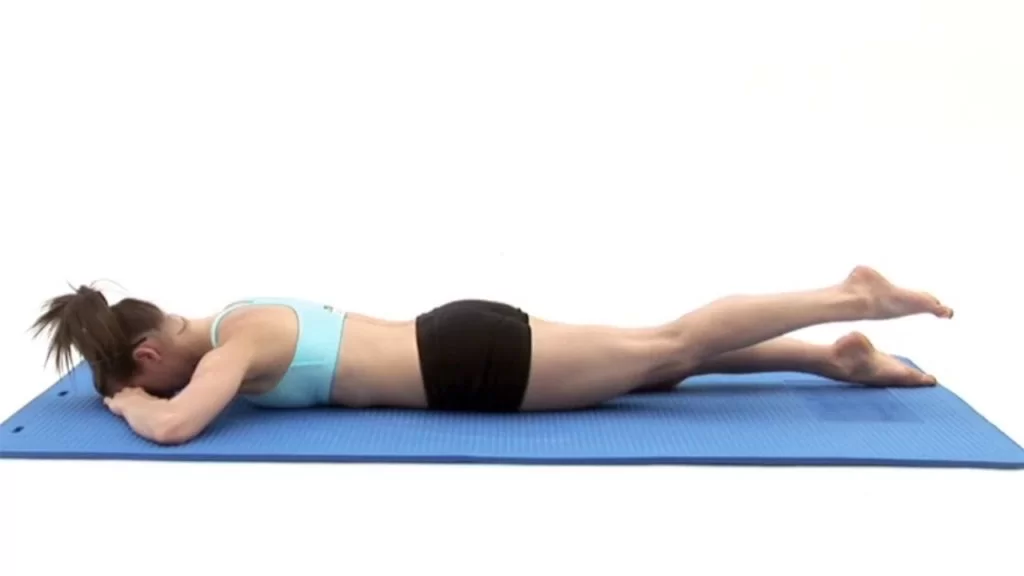
How to do this strengthening exercise:
To perform this exercise, the patient can use a mat to add padding underneath. Your legs should be straight behind you while you lay on your stomach. The patient can rest his neck on his hands. Contract the glutes and hamstrings of the right leg and lift the leg as far as possible without causing pain. Remember to keep your pelvis on the ground during the exercise. Hold the elevated leg in place for five seconds. Lower your leg, pause for two seconds, and then repeat. Do one to three repetitions of ten on each leg.
Hamstring curl:
This exercise strengthens the glute and hamstring muscles. Maintaining stability in both the upper body and the hips also requires strong core muscles.

How to perform this strengthening exercise:
The patient must stand with their back to the wall or lean on a chair to perform this exercise.
Hip distance should separate the feet. Flex the knee of one foot while raising the heel upward.
Tell the patient to extend their reach as far as they can while maintaining their hips forward and their upper limb stable. For 8 to 10 seconds, hold.
Relax and return to the starting posture at the same time.
Perform one to two sets of 10 to 15 reps on each leg.
What not to do:
Use a lighter weight the first time you try this workout. Beginners should start with the lightest weight possible and gradually increase as their strength increases to higher weights.
Hamstring curls on a weight bench:

A variation of the standing hamstring curl is this exercise.
If the patient has access to a weight bench designed specifically for this exercise, they may try this variation. Depending on how much weight is applied, this may be harder than the standing hamstring curl.
How to do this strengthening exercise:
The patient must lie face down on the bench with their knees closely spaced to perform this exercise. To ensure stability, hold the handles. Put a weight on the feet. Just above the heels should be the weight.
gradually bent both knees, lifting the weight with the help of the legs. Maintain a smooth motion as you raise the weight until your knees are at a 90-degree angle.
Hold the weight in place for five seconds before lowering it gradually.
Do as many as ten repetitions.
What to avoid:
Use a lightweight when performing this exercise for the first time. Beginners should start with the lightest weight possible and progress to heavier ones as their strength increases.
Buttock Kicks:
Another excellent hamstring-strengthening exercise that doesn’t involve using the knee joint is buttock kicks. Additionally, it promotes circulation and increases knee flexion.
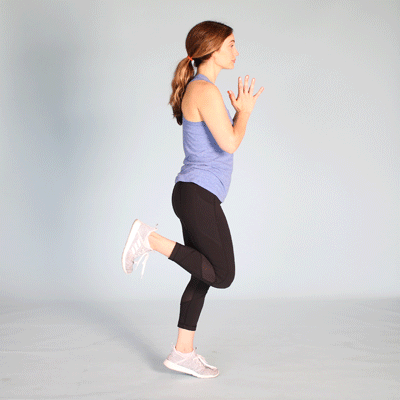
How to perform this exercise: On the floor or in bed, lie on your stomach with your legs straight.
As far as you can, lift your foot off the ground and bring it towards your bottom. Return to the starting position gradually.
10–25 times, three times daily.
Your goal is to reach your bottom with your heel.
Hook your good leg underneath the bad and use it to lift the bad leg up to make the exercise simpler.
Use a weight, such as a shoe or ankle weight, to make the exercise more difficult.
Step-up exercises:
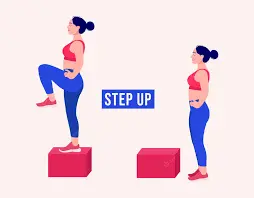
How to do these exercises:
The patient can utilize a large, stable stool that is no more than six inches tall to carry out this activity.
Allow the right foot to follow the left foot as you ascend the stool. The right foot should hang behind this rather than be on the stool.
Hold for up to five seconds while keeping the body weight on the left foot.
Start by lowering your right foot gradually, then your left.
Change legs, rising with your right foot first.
Do as many as ten repetitions.
What not to do:
Avoid locking your knees when performing this exercise. It is best to keep the knees slightly bent.
Any part of the stepping foot should protrude beyond the edge of the stool or platform.
People with balance issues shouldn’t engage in this activity.
Step-down exercise:
How to perform this strengthening exercise:
Place yourself upon a step.
Hold on to anything that is still as support.
Throughout this exercise, keep the knee of the leg that is on the step in line with the toes.
Slowly lower the other foot to the ground.
Go back to your starting point.
20 repetitions are needed.
Progress: Carry out the workout more slowly.
Employ a higher step.
Utilize fewer armrests.
Single-leg dip:

How to perform this strengthening exercise:
The patient can perform this exercise by Using two sturdy, high-backed chairs, one on each side of the body, with the backs of the chairs placed near the arms. Put a hand on the backside of each chair for stability.
Raise the left leg twelve inches or so off the floor. The right leg must bear the entire weight.
Pushing weight onto the supporting leg’s heel, gradually bend down two inches.
Take ten seconds to hold.
Slowly upright yourself.
Repeat and complete the other sides.
Up to ten to fifteen repetitions may be made.
What not to do:
When elevating the leg, do not slouch. Hold a straight upper body and back.
Prevent the knee from crossing the toes of the supporting leg.
Knee extensions or long arcs:
You can lessen the strain on your knees by strengthening your quadriceps using your own body weight rather than a weighted machine.

To perform this exercise:
Sit tall in your chair.
Place your feet on the ground with your hips spaced.
Lift one leg as high as you can while remaining seated by straightening your spine and contracting your thigh muscles.
Return to the starting position after a three to five-second pause.
Perform two to three sets of 10 repetitions for each leg.
Knee Flexion (Standing):
How to perform this exercise: On a 2-inch board or little step, stand.
Bend your knee to a 90-degree angle while keeping your thigh in a straight line with your upper body. Slowly lower yourself. Maintain foot flexion throughout the motion. To keep your thigh aligned with your trunk, you might lean your leg against a table.
Change to the other leg and repeat after 10 reps. As necessary, perform 2-3 sets.
Light ankle weights can be added as you gain strength to increase resistance. This workout stretches your quads while strengthening your hamstrings.
Knee Marching:
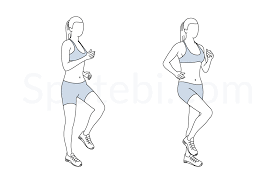
Knee Marching is one of the knee-strengthening exercises that train the quadriceps without putting any weight through the knee joint, making it ideal for the first few weeks after knee surgery or injury.
How to perform this strengthening exercise:
occupy a chair and place your feet on the ground.
March each leg up and down separately. Step up with your foot and knee, then step back down.
To prevent your knee from becoming stiff, repeat for roughly a minute, twice a day, and if you sit for longer than 20 minutes.
By increasing the ankle weight or shoe, you can advance knee-strengthening workouts.
Sit to stands:
Despite its apparent ease, this exercise serves to increase knee mobility while simultaneously strengthening the quadriceps, hamstrings, and glutes. It also enhances overall fitness and knee function.
These knee-strengthening exercises target two or three different muscle groups at once.
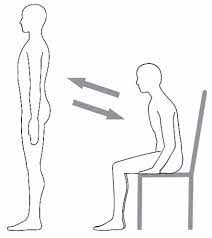
How to perform this strengthening exercise:
The patient will require a chair to perform this exercise.
Stand up, then sit down without using your hands as a crutch.
Make sure that every movement is controlled and slow. Continue until the patient is unable to perform it any longer.
Repeat two more times after a brief period of rest. If a chair is too low, start by getting up from the cushion and taking it off when the patient no longer needs it.
You can make this exercise simpler:
a. pulling up through your arms too;
b. raising your chair higher
You can make it harder by:
a. By not using your arms,
b. utilizing a lower chair,
c. doing knee strengthening exercises faster,
d. holding a heavy object—such as a bag of books—during this knee exercise.
Monster Walk (Side Steps):
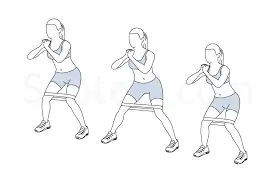
How to perform this strengthening exercise:
With a resistance band resting just above your ankles, stand with your feet hip-width apart, knees slightly bent, and toes pointed forward.
Step to the left while keeping your knees slightly bent and your upper body upright. Step just far enough to encounter resistance without going too far so that your knees buckle.
For a total of 10 to 15 steps, keep moving to the left. Stop, then take the same number of steps to the right, going back to where you started. It’s one set.
Step 10 to 15 times to each side in three sets.
Quads exercise with roll:
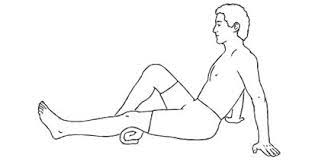
How to perform this strengthening exercise:
The patient must sit on the floor, a sofa, or even a bed with their legs fully extended in front of them. One knee should be covered by a towel.
As if extending the knee, press firmly down on a towel.
Move the foot and toes in your direction so that the patient can feel the calf muscles stretch and the heel rise off the ground.
After holding for ten seconds, take ten seconds to relax.
Repeat the exercise with the right leg 10 more times.
Hamstrings Clenches:
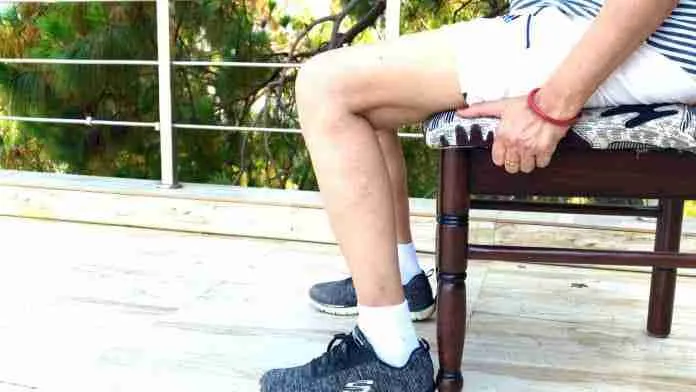
Hamstring Clenches are ideal after a knee injury or surgery since they aid to strengthen the hamstring muscles without requiring the knee to be moved.
How to perform this exercise: Place your heels against the chair’s leg and your feet firmly on the floor while you sit in a chair.
You should feel a tightening or clenching in the back of your thigh when you firmly press your heel into the chair leg. 3–5 seconds of holding
10–20 times, twice daily.
You shouldn’t shift your foot while doing this knee workout.
Buttock Clenches:
If you want to build strength in your glutes, buttock crunches are the ideal place to start.
How to perform this exercise: begin lying down or rising from a chair.
For three seconds, clench your buttocks as firmly as you can. You should feel a tiny movement to get you out of the chair.
Every 3–4 hours, repeat 10–20 times.
Try doing this knee exercise while lay down with your legs extending or your knees bent if doing so makes you uncomfortable.
Ball Clench Extensions:
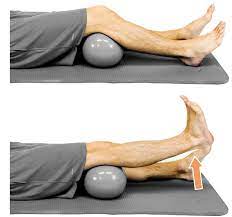
How to perform this exercise:
Place the ball between your knees while lying on your back with a towel pulled up beneath your knees.
Gently pinch the ball of your buttocks while you lift one heel off the ground to straighten your knee.
Hold the ball firmly in your fist for three seconds, then gradually bring your foot back down.
Repeat 10 times, aiming to reach 25 reps by progressively increasing the number of repetitions as your strength improves.
Twisted Leg Raise:
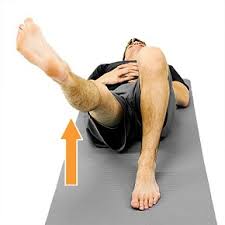
How to perform this exercise:
On your back, bend the knee of the opposite leg while keeping the other leg straight. This relieves lower back stress while you exercise the straight leg.
Lift your foot up until your thighs are parallel after externally rotating your foot around 20 degrees.
Hold for three seconds, then gradually lower yourself while maintaining your foot outward.
Again, this vastus medialis exercise serves to stimulate the VMO by keeping the leg turned outward.
Heel raises:
Your calf muscles, which are located on the rear of your lower legs, are strengthened by this exercise.
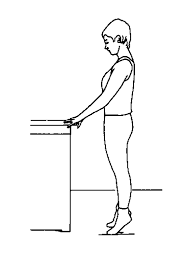
To perform this exercise:
Place your feet shoulder-width apart as you stand. Select a position adjacent to a wall or hold to the back of a chair for support.
To stand on the balls of your feet, raise both of your heels off the ground.
Gradually return your heels to the beginning position. When performing this exercise to develop your calf muscles, control is key.
Make an effort to complete two or three sets of 10 repetitions.
Solo Heel raises:
a quick workout that will assist the calf muscles to become stronger to support the knee.
How to perform this exercise: Holding onto a table or wall or any sturdy object, stand on one leg.
As high as you can, lift your heel off the ground by pushing up into your toes. Hold for 3–5 seconds, then gradually decrease.
10 to 30 times, twice daily.
It’s a good indication that your calf muscles are strong when you can complete 30 repetitions on just one leg.
One Leg Standing: (stage 1)
In order to ensure excellent control of the knee and aid in preventing further knee injuries, it is crucial to concentrate on restoring both balance and stability, which are frequently impacted by weak knees.
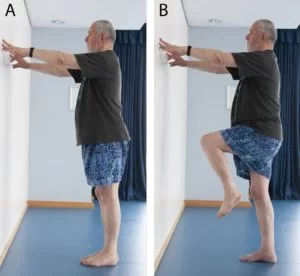
How to perform this exercise: Try standing on one leg with your eyes closed to determine if you should include balance exercises in your regimen of knee-strengthening exercises. Do some balancing training if you can’t hold it for a minute.
For stability, take a chair or a wall nearby.
As long as you can, stand on one leg while raising your good leg. It’s normal to sway a little.
Do this twice every day for 5 minutes each time, such as when cleaning your teeth.
Close your eyes while performing the exercise to exert more effort.
One Leg Standing: (stage 2)
This exercise helps your body learn the minor adjustments required for proper balance while also improving balance and proprioception.

How to perform this exercise: The toes and heel should be off the ground while you stand with a little towel rolled up below the arch of your foot.
Stand on one leg as long as you can by raising your good leg.
Performing this twice a day for 5 minutes
To increase your level of difficulty:
- Extend one arm in various directions.
- Shut your eyes.
- Toss and catch a ball;
- Slightly flex and straighten your knee;
The Clamshell exercise: ( stage 1)
The Clam is one of highest preferred exercises for strengthening the knees. Anyone with knee pain should do it since it helps to strengthen the glutes to support the knee and avoid too much weight from passing through the inside side of the knee.
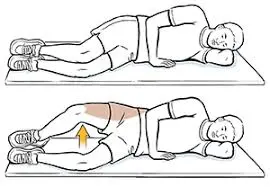
How to do this exercise:
Lay on your side with your knees bent at a 45-degree angle and your legs stacked.
Place your head on your lower arm and support your body with your upper arm. As the upper hip has the propensity to sway backward, make sure your hipbones are stacked on top of one another.
Pulling your belly button in will help to activate your abdominals and stabilize your spine and pelvis.
As much as you can without moving your hips or pelvis, lift your upper knee while keeping your feet together. Keep the ground under your lower leg firmly in place.
After pausing, put your upper leg back in its initial position on the ground. 20 repetitions on each side.
Clamshell exercise with a resistance band: (stage 2)
A resistance band can be used to increase the difficulty of a standard clamshell rotation. In order to build a solid core and back, this will help to work the glutes and hamstrings even more.
How to do it:
At the level of the knees, wrap the band around both legs.
Lay on one side, stacking your hips and legs with your knees at a 45-degree angle.
Your core will be stabilized if you contract your abdominal muscles.
While keeping the hips and pelvis stationary, elevate your upper knee as high as you can while keeping your feet firmly planted in place. Keep your lower leg on the ground and don’t let it budge.
Before bringing the top knee back to its starting position, take a little pause at the top. Execute 20 reps on each side.
Lunges:
How to perform this exercise for strength:
Exercises called forward lunges help you keep your balance while building stronger legs and hips. The patient must stand with their feet hip-width apart and place their fists back on their hips to perform the lunges exercise.
Now forward one step. Flex both knees while lowering the hips gradually, being careful to prevent the front knee from crossing the toes.
After a brief period of holding, lift up off the front heel to return to the starting position.
On the other leg, repeat the same exercise.
Forward Lunge:
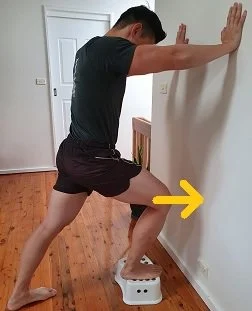
How to do it:
Step one foot onto the step.
Hold on to a wall in front of you with both of your hands.
Throughout this exercise, maintain the knee of the leg on the step in line with your toes.
Squat forward.
As much as you can advance your knee without allowing it to click is recommended.
Use your hands as much as necessary to support the situation.
20 repetitions are needed.
Progression: Permit the knee to advance more.
Reduce the amount of support your arms are giving you gradually.
Reverse Lunge:
Because they strengthen your glutes and quadriceps, reverse lunges are excellent for treating knee pain. Reverse lunges are preferable to forward lunges if you have knee pain since they place less stress on the knee in the forward direction.
How to do it:
Your feet should be approximately hip-width apart as you stand with your arms at your sides.
Step back three steps with your right leg, bending your knees to a 90-degree angle. Your front thigh should be parallel to the ground, and your rear knee should be just an inch off the floor.
As you press into your left heel and straighten your left leg, keep most of your weight on your front leg.
Reposition your right leg to the beginning position, then get to your feet.
Tips:
The front foot should be firmly placed so that the heel is on the ground, and both feet should be directed straight ahead.
Maintain a straight back and a comfortable, neutral neck while gazing forward.
Hold on to a counter or a railing for support if necessary.
Modifications:
Don’t bend as much if the complete range of motion causes discomfort. Before you begin to experience discomfort, stop.
Only bend the front knee and keep the back leg straight.
Lateral Lunge:

A number of muscles in your lower body, including your glutes, hamstrings, quadriceps, and inner thighs, are strengthened by side lunges. Even your core gets a workout.
How to do it:
Stand with your hands by your sides and your feet shoulder-width apart.
With your hips tucked in and your right knee bent so that it is directly above your right ankle, take a big step out to the right.
Make sure both of your feet are parallel to one another and facing forward while maintaining a straight left leg (without locking your knee). Keep your spine neutral while lifting your chest.
As you stand back up, push off your right foot and extend your right leg.
Tips:
Keep both feet perfectly flat on the ground with their toes pointing straight forward and step out with your moving foot as wide as you can.
Make sure your moving knee is above your foot and not bowing out to the outside or inward towards the midline of your body.
Modifications:
Reduce the depth of the knee bend.
Hip Bridge: (stage 1)

How to perform this strengthening exercise:
The patient must lie supine with both knees flexed and heels flat on the ground, about 6 inches away from the buttocks.
Press into the heels and lift the hips off the floor while contracting your core.
Keep your ribs relaxed and in a straight line from your shoulders to your knees rather than arching your lower back.
Hold for 10 seconds, then gradually let go.
Raise one leg into the air as the patient improves to form the single-leg bridge.
Single-leg bridge: (stage 2)
Bridging is a beneficial knee-strengthening exercise because it works the quads, buttocks, and hamstrings while also strengthening the hamstrings. Make sure you can complete Stage 1 of Bridging before continuing.
How to perform this exercise: Lie on your back with your feet on the floor or bed and your knees bent to about 90 degrees.
Lift your bottom off the bed as high as you can without arching your back by clenching your buttocks. Next, raise one leg. Hold for 3-5 seconds, then gradually let go.
1-2 times per day, repeat 10–25 times.
Top Tips:
- Don’t allow your back arch as you raise up; instead, let your bottom do the lifting.
- Continue to breathe normally and don’t hold your breath.
- During the exercise, keep your hips as high as you can without letting them drop.
Bridge With Ball:
Your hip adductors, or inner thigh muscles, as well as your hip extensors, or glutes and hamstrings, are recruited when you add the ball to the glute bridges, the expert claims. Your knees are better protected if these areas are stabilized and strengthened.

How to do this exercise: Lie on your back with your knees bent, your feet flat on the ground, and your arms at your sides. Between your knees, place a Pilates ball and squeeze it to prevent it from falling.
Squeeze your glutes, plant your heels firmly, and lift your hips upward as you exhale.
Raise your hips until your knees, hips, and chest are in a diagonal line.
Take a moment to pause here.
Reverse the motion, then get back to your starting place.
Tips:
When you’re in the bridge position, avoid overextending your spine. To avoid having your low back arch, lift your glutes until it is flat.
Modifications:
Avoid the bridge motion and perform isometric ball squeezes in its place.
You can also use a cushion if you don’t have a ball.
Hip Adduction With Ball:
Your hip adductor muscles need to be strengthened in this exercise. Strong hip muscles protect the knees from being positioned incorrectly, which reduces the need for strain.
How to perform it: Lay on your back with your arms at your sides, your knees bent, and your feet flat on the ground. Kneel down and place a Pilates ball there.
As much as you can, squeeze the ball with your inner thighs.
Release gradually, being careful to prevent the ball from escaping.
Tips:
Keep your feet away from your butt to avoid putting extra strain on your knees. Your feet should be far apart such that if you reach out, you can’t touch them, but close enough so that if you reach out and lean slightly to one side, you can tap them with your fingertips.
Modifications:
Perform the same exercise while extending your legs straight instead of bending your knees.
Kneecap Clenches:
The most effective way to build up the muscles on the inside of your knee that control how your kneecap moves is, to begin with kneecap clenches. Moreover, they support improved knee stability.

How to do it: Place a soft ball between your knees while sitting in a chair with your feet hip-width apart.
Knees clenched, buttocks clenched, and knees softly squeezing the ball. Hold for 3-5 seconds, then release.
10–20 times, twice daily.
Top Tips:
- Use your fingertips to feel tightness in the VMO muscle.
- When squeezing the ball, make sure your knees, not your hips, are doing the squeezing.
Side-Lying Hip Abduction:
The goal of this exercise is to develop the muscles in the outer thighs and hips, which will aid in maintaining a more neutral position for the knees.
How to perform it:
Stack your hips directly on top of one another as you lie on one side. the bottom knee is bent.
Lift your upper leg as high as you can towards the ceiling while keeping your toes flexed. Make sure to lift with your outer hip muscles.
Return your leg to the ground slowly.
Tips:
Keep your hips stacked and don’t elevate your top leg higher than a 45-degree angle.
Modifications:
Lie on your back with your legs extended. Move the leg in a “snow angel” motion out from the body.
Supine Heel Slide:
Another one that aids in hamstring strengthening and increases blood flow to the knees is this one.
How to do it:
Lay your back flat. Extend your second leg while bending one knee at a 90-degree angle so that your foot is flat on the ground.
The foot of your extended leg should be placed underneath a slider, which you should then draw in while bending your knee so that it is placed next to the opposite knee.
After pausing for a brief moment, slide your leg carefully back out while maintaining the toes flexed.
Change sides and keep switching.
Tips:
Do not slip your feet too far back as this will put extra strain on your knees.
Modifications:
Reduce the range of motion and stop when pressure begins to build.
Single leg Deadlift:
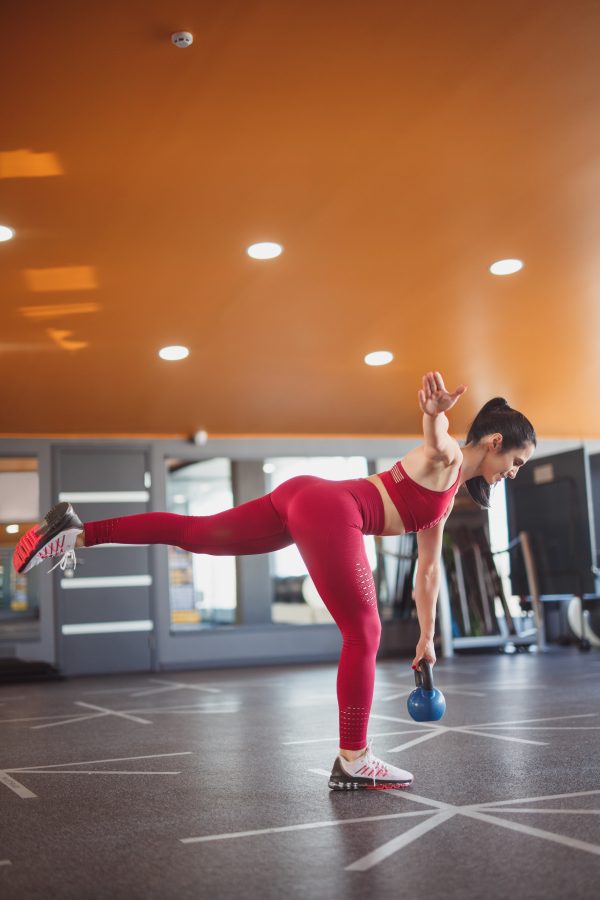
How to perform this exercise:
The patient must stand with both feet beneath their hips to do this strengthening exercise.
Transfer the weight to the left leg, which should be straight and have a slight bend in the knee. The right leg should be straight as you begin to push the right foot back as if the patient were stepping the bottom of the foot on a wall behind you.
At the same time, carefully begin to tilt the trunk forward at the waist until it is nearly parallel to the floor.
At all times, the arms should be straight, shoulder-height, and parallel to the floor.
The body must be in a straight line from the top of the head to the bottom of the right foot while in the bottom position.
After that, begin bringing the right leg forward while maintaining its straightness. Finally, lift the trunk until the patient is standing once again.
It is repeated once. After completing all reps on one side, swap legs.
Standing Terminal Knee Extension With Resistance Band:
This exercise, which is yet another fantastic quadriceps exercise for sore knees, improves quadriceps muscle strength, which ultimately supports the knee and lessens pain.
How to perform this exercise: An anchor should be wrapped with a resistance band. Walk far enough away from it so that the band has almost no wiggle room. Wrap the band’s other end over one knee while standing facing the anchor.
Bend your knee slowly and deliberately so that you can fully control the resistance with your knee and avoid simply caving into the band’s pull.
Adjust your knee once more.
When pulling your knee into an extended posture, avoid hyperextending it.
Do not let your heels lift off the ground or let your hips move.
Modifications: If this is too difficult, omit the resistance band and concentrate on isometrically tightening the quadriceps.
Standing Hip Abduction With Resistance Band:
Your hip abductor muscles are the focus of this move. There is a strong correlation between hip strength and knee position. By strengthening your hips, you can prevent bad knee alignment and lessen strain.
How to do it:
An anchor should be wrapped with a resistance band. Walk far enough away from it so that the band has almost no wiggle room. Place the other end of the band around your right ankle while keeping the anchor to your left as you stand.
Lift your right leg slowly away from your body’s midline and out to the side without letting the band dominate the motion.
Bring your leg back next to the other by pulling on the band.
Tips:
To keep your lower back from getting sore, maintain a strong core during the entire workout.
Modifications:
Try looping the band higher up your leg if the band causes your knee to experience some side-to-side tension.
Remove the resistance band and perform the exercise on your own.
Standing Hip Adduction With Resistance Band:
How to do it:
An anchor should be wrapped with a resistance band. Walk far enough away from it so that the band has almost no wiggle room. Place the opposite end of the band around your right ankle while keeping the anchor to your right.
Lift your right leg slowly away from your body’s midline and out to the side without letting the band dominate the motion.
Bring your leg back next to the other by pulling on the band.
Tips:
For this motion, you can also utilize a small band. Just wrap it twice around the ankles.
Modifications:
Lift the leg out to the side while utilizing the stationary leg as your anchor, holding onto a bar or countertop for support.
Try looping the band higher up your leg if the band causes your knee to experience some side-to-side tension.
Remove the resistance band and perform the exercise on your own.
Short Arc Quadriceps exercise:
In contrast to several other more conventional quad-strengthening exercises, this one works without putting any strain on the knee joint.

How to perform it:
Place a bolster, towel wrapped up, or foam roller beneath each knee as you lay on your back. Keep the ground under your lower back still.
Squeeze the quads of one leg until it becomes rigid and the knee is fully extended.
Prior to relaxing the leg once more, hold the contraction for a short period of time.
Tips:
Avoid elevating your leg off the bolster, towel, or foam roller because doing so will put pressure on your hip joint rather than the muscles that surround your knee joint.
Modifications:
Reduce the range of motion in the leg by placing a smaller bolster, folding a pillow or towel beneath the knees, or both.
Wall Squat:
Muscles involved: Quadriceps and gluteal muscles.
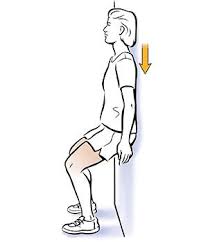
How to perform this exercise: Stand facing a wall with the back, hips, shoulders, and head all parallel.
While maintaining the back and shoulders against the wall, step both feet out approximately 24 inches. Limit the distance between your feet to hip width.
Move the back slowly down the wall until it is just above a sitting posture.
After holding for 5 seconds, slide back up.
Repeat.
What to avoid:
Don’t crouch down too low. The toes shouldn’t be covered by the knees.
Avoid making quick, rapid movements. Exercise should be done easily and slowly.
Split Squat:
How to perform it:
The patient must assume a staggered posture with their feet hip-width apart and one-foot several feet in front of the other, gripping a dumbbell in each hand while they do the split squat.
To lower the body into the lunge (or split squat) until the front thigh is parallel to the floor, contract your core muscles and flex both knees.
Be sure to maintain a firm core, a straight spine (the trunk may need to bend slightly forward to do this, but that is okay), and shoulders back rather than rounded or even stooped.
As you straighten that knee and return to standing, push through the front foot’s heel.
It is repeated once. Perform around 10 reps on one side, then switch legs and go again.
Half squat:
A wonderful workout for strengthening your quadriceps, glutes, and hamstrings without placing too much strain on your knees is the half squat.
To perform this exercise:
Place your feet shoulder-width apart and squat. For balance, put your hands on your hips or in front of you.
Slowly lower yourself by about 10 inches while keeping your head straight. The midway point between this and a complete squat is here.
Push through your heels to stand up after a brief pause.
Make an effort to complete two or three sets of 10 repetitions.
Single leg squat:

How to perform this exercise: Start by placing your right foot forward. Holding it straight and just in front of your body, raise your left leg. Alternatively, you might just maintain your left leg up and bend your knee. For balance, you can hold your arms out in front of you or at your sides.
Throughout the exercise, keep your torso up and your core tight. Start driving your hips back as you squat down into a position. Get as low as you can while maintaining parallel hips to the ground.
Activate your glutes as you push off with your right foot to stand back up. Between reps, try to maintain your left leg raised. Before transferring to the left, complete 5 to 10 repetitions on this side.
Make three sets.
Modified Plank:
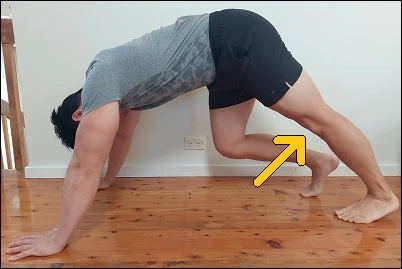
How to perform this exercise: Take the position that is indicated in the above image.
The knee is locked straight.
Try to feel the VMO muscle contracting strongly.
Take a 5-second hold.
twenty times.
Progress: Only use one leg for this workout.
Exercises to Strengthen Your Knee By Muscle Group:
Here, we’ve looked at a variety of exercises for strengthening the knee that targets all the muscles that surround it. Choose from one of these programs to strengthen your knees if you prefer to concentrate on one muscle group at a time.
Exercises to Strengthen Your Quadriceps:
The muscles on the front of the thigh known as the quadriceps are responsible for bending the knee. For standing up from a chair, climbing stairs, walking, and running, you need strong quadriceps. One of the most typical reasons for knee discomfort is weak quadriceps.
Exercises to Strengthen Your Hamstrings:
The muscles on the back of the thigh that bend the knee are known as hamstrings. These muscles need to be strong and long in the right proportions. Running and knee twisting both heavily rely on the hamstrings.
Exercises to Strengthen the Glute:
One of the most frequent causes of knee discomfort is weak glutes. The glutes, or buttock muscles, are sometimes overlooked in knee strengthening exercises despite being crucial in ensuring that forces pass through the knee evenly. They are really worthwhile to perform because weak glutes are a common cause of knee discomfort. It is true that strengthening the glute medius after knee surgery decreases pain and enhances function.
Strengthening of the Vastus Medialis:
The management of the kneecap’s motion by the vastus medialis muscles is crucial for the stability and control of the knee. In contrast to the other exercises for strengthening the knee, this muscle has to be exercised differently.
You can go to the following phase if you’ve completed these exercises for strengthening your knees:
Intermediate Knee Strengthening Exercises: Build on the exercises you have already done and start including things like squats and step-ups for intermediate knee strengthening.
Advanced Knee Strengthening Exercises: For serious rehabilitation, we really go to town with various lunge and plank variants as well as box jumps.
Theraband Exercises For Legs: Resistance bands may provide some diversity to your theraband leg exercises, allowing you to alter things and exert more effort.
Don’t forget that muscles require both sufficient length and strength. When knee stretches are combined with knee-strengthening exercises, people gain the most from them.
Post-exercise stretching:
This is essential to do after any activity in order to stretch the utilized muscles. Stretching promotes flexibility and reduces discomfort and injury.
Stretch your quadriceps:
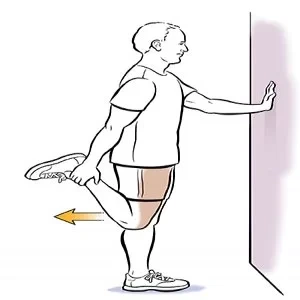
How to perform this stretching exercise: The patient can extend their quads For balance, cling to the chair’s back or place one hand on a wall.
Hold the ankle with one hand while raising your left foot behind your torso. The knees should be closely spaced apart, and the back should be straight.
Bring the heel as near to the glute as you can without straining or hurting yourself.
Hold for up to 30 seconds before lowering the leg gradually.
After doing three sets on the left side, go on to the right leg.
Toe touches:
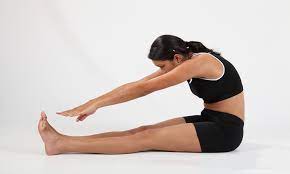
How to perform this stretching exercise: It is possible to stretch the hamstrings in the rear of the legs using a variety of approaches.
One method is conventional toe touching, which involves keeping the feet close together, slowly flexing the hips, and extending the arms downward.
While keeping the legs straight, avoid locking the knees.
Bring your fingers to the tips of your toes and hold for 30 seconds.
It could be impossible to reach the toes at first. Try to bring the fingers as close to the toes as you can without inflicting pain in this situation.
Hamstring stretch while standing:
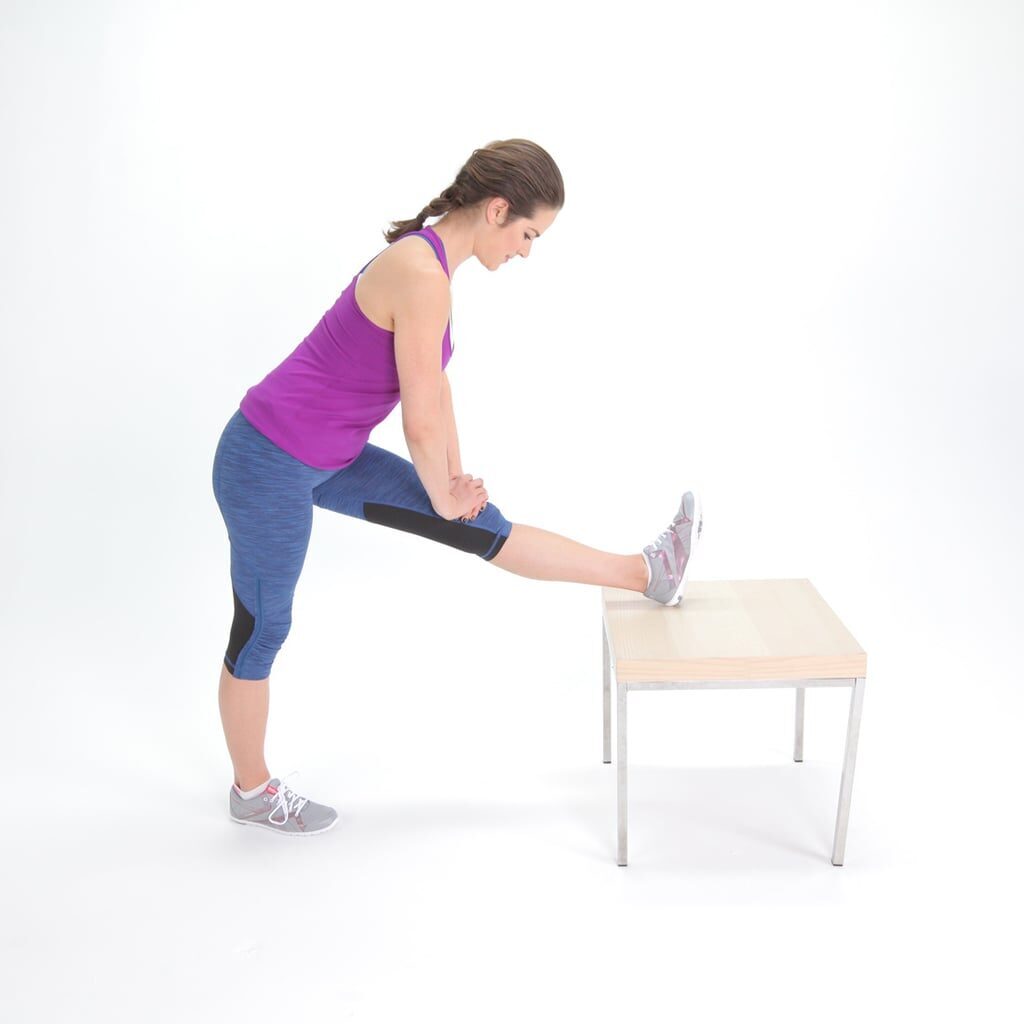
How to perform this stretching exercise: This method is also useful for stretching the back of the leg, and it is easier on the lower back than toe touches. Performing this stretch With your feet no wider than shoulder-width apart, stand up straight.
Lengthen the left leg outward a few inches in front of the torso, with the hips slightly flexed. Permit the right leg to progressively flex.
The chest must be lowered gradually while maintaining a straight back.
As much as you can without hurting yourself, stoop. Hold for about a minute.
Bring the leg back slowly to the body and stand tall.
Likewise, repeat with the right leg.
Other exercises for the weak knee:
After strengthening your knees, think about including low-impact workouts in your program. In comparison to high-impact workouts like sprinting or leaping, these exercises often place less strain on your joints.
Low-impact workout examples include:
Taichi
yoga
elliptical machine
stationary cycling,
walking,
water aerobics
Swimming: Fortunately, swimming is among the best exercises you can use to heal damaged knees. You can strengthen your knee joint by treading water, swimming front crawl, backstroke, or just kicking laps with a flutter board. These exercises will also offer you an excellent cardio workout. You can even try swimming underwater while jogging or doing water aerobics.
How Much Should You Do:
You may perform each of these knee-strengthening exercises for an increased number of repetitions as your muscles get stronger.
Before you see much improvement in your knee pain, you will probably need to perform knee-strengthening exercises at least four times a week for about a month. At that point, you may also want to add in some knee stretches; it’s important to have enough strength before you start stretching, otherwise, you risk making things worse.
To Get the Best Results from your knee muscle strengthening get advice on how to exercise safely and efficiently.
When you’re ready, move to the intermediate and advanced knee strengthening exercises to further reinforce your muscles.
How to Exercise With Bad or Weak Knees:
By exercising in low-impact ways, you may lessen the effects of gravity and your own body weight on your knee joints. You may lessen the unneeded strain on your knee by using softer surfaces, such as cushioned flooring.
When choosing lower-body exercises, choose “closed-chain” ones that maintain your knee in a more secure posture by having your feet firmly planted on the floor.
These motions will result in better movement quality, which will relieve pressure on the knee, reduce joint inflammation, and deliver healing blood to the area to hasten the healing process.
When did the patient stop performing knee-strengthening exercises?
If there is a hip injury,
there is a knee injury,
If a patient recently underwent leg surgery.
During this activity, the patient should report any pain.
Choose an easier form of this exercise if the patient has a balance issue.
if the physical activity makes the ache worse.
Exercise gently and steer clear of jerky movements.
FAQS:
There is no universal treatment for weak knees because there are so many causes of the condition. It has been discovered that physical therapy and rehabilitation programmes are useful in treating knee issues. Physical treatment on a regular basis can assist increase quadriceps muscle strength and range of motion while easing general knee weakness stiffness and discomfort. However, there are several choices available for both reducing pain and symptom relief. There are even alternatives for joint replacement knee surgery if the problem is severe enough.
Symptoms of Weak Knees:
stiffness and swelling in the knee.
Redness.
a feeling of burning.
weak points and instability.
the joint makes popping sounds when it is bent.
the inability to bend the knee straight.
difficulty rising from a seated posture to a standing one.
Arthritis
Sprains and strains
Ligament or cartilage damage
Knee joint infection
A lack of physical activity
Syndrome of the iliotibial band
Muscle weakness
It has been discovered that physical therapy and rehabilitation programs are useful in treating knee issues. Physical treatment regularly can assist increase quadriceps muscle strength and range of motion while easing general knee weakness stiffness and discomfort. As they might benefit the most, it may be especially advised for people with mild pain and knee weakness. Additionally, the physiotherapist might suggest some exercises that can be done at home with the right footwear. In order to lessen the strain on the knee, they could also assess the patient’s posture and encourage them to improve it.
Stretch as frequently as you can. A straightforward stretch may lubricate and feed the cartilage with synovial fluid and help you avoid joint stiffness. Stretching activities like yoga and pilates can ease osteoarthritis symptoms while simultaneously building muscular strength to guard against additional joint damage.
Chair or wall squats. Squats should be performed while standing in front of a chair or up against a wall if your knees are weak to prevent you from falling over.
Complete Chair Sits-to-Stands.
Step-ups or knee marching, Lunges, Straight Leg Lifts, Side Leg Raises, Short-Arcs, etc.
Calf and the abductor rise.
If there is a hip injury, the patient
there is a knee injury, the patient
If a patient recently underwent leg surgery.
During this activity, the patient should report any pain.
Choose an easier form of this exercise if the patient has a balance issue.
if the physical activity makes the ache worse.
Exercise gently and steer clear of jerky movements.
By exercising in low-impact ways, you may lessen the effects of gravity and your own body weight on your knee joints. You may lessen the unneeded strain on your knee by using softer surfaces, such as cushioned flooring.
When choosing lower-body exercises, choose “closed-chain” ones that maintain your knee in a more secure posture by having your feet firmly planted on the floor.
These motions will result in better movement quality, which will relieve pressure on the knee, reduce joint inflammation, and deliver healing blood to the area to hasten the healing process.
On your back, bend the knee of the opposite leg while keeping the other leg straight. This relieves lower back stress while you exercise the straight leg.
Lift your foot up until your thighs are parallel after externally rotating your foot around 20 degrees.
Hold for three seconds, then gradually lower yourself while maintaining your foot outward.
Again, this vastus medialis exercise serves to stimulate the VMO by keeping the leg turned outward.
The best non-surgical treatment for osteoarthritis is exercise. The strong and flexible muscles may protect the knees from harm and maintain their health.
Regularly strengthening your quadriceps can help to make it simpler to extend your knee and flex your hip.
Helps the quadriceps muscles to get stronger.
Increases the kneecap’s stability by doing this.
Aids in protecting the knee joint from harm. Aids in increasing leap height and in improving all-around athletic abilities.
Decreases the likelihood of getting knee osteoarthritis.
Improving stability and balance. Simple movements like walking, bending, sitting, and running become easier with stronger knees.
Exercises for knee strengthening serve to increase knee strength and control, which is very important:
To regulate and stabilize the knee
Maintain proper foot, knee, hip, and back biomechanics
To lessen the possibility of harm
It provide complete pain-free mobility
To ensure functioning properly
The recovery period for knee sprains or even strains is normally 2 to 4 weeks. Trauma-related major injuries might take four to twelve months to heal. Of course, the length of time it takes for the patient to recuperate will depend on the treatment being given and their lifestyle.
Over time, that pressure and normal wear and tear cause damage. Both muscles and ligaments deteriorate. Menisci, the two cartilage shock absorbers on either side of the knee, start to degenerate. The knee is where the ends of the leg bones connect, and that area is also covered in articular cartilage.
Due to their high protein content, legumes help the body replace the collagen needed to regenerate the cartilage in the knees. They include a lot of protein, but they also contain amino acids and lysines, both of which are essential for naturally repairing knee cartilage.
Yes, it is important to do stretching exercises after strengthening exercises of knee muscles. This is essential to do after any activity in order to stretch the utilized muscles. Stretching promotes flexibility and reduces discomfort and injury. Don’t forget that muscles require both sufficient length and strength. When knee stretches are combined with knee-strengthening exercises, people gain the most from them. After working out, you should stretch the muscle areas that you focused on during the activity. This will improve blood flow and circulation, which will make it easier for waste materials to be removed from these places and avoid pain or damage during subsequent activities.

